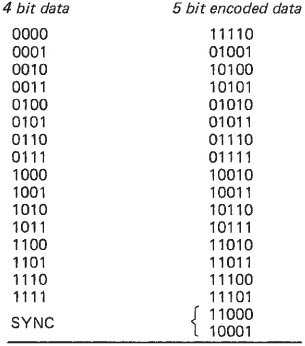3.8 Group Codes
| | ||
| | ||
| | ||
3.8 Group Codes
Further improvements in coding rely on converting patterns of real data to patterns of channel bits with more desirable characteristics using a conversion table known as a codebook . If a data symbol of m bits is considered , it can have 2 m different combinations. As it is intended to discard undesirable patterns to improve the code, it follows that the number of channel bits n must be greater than m . The number of patterns that can be discarded is:
2 n - 2 m
One name for the principle is group coding, and an important parameter is the code rate, defined as:
R = m/n
It will be evident that the jitter margin T w is numerically equal to the code rate, and so a code rate near to unity is desirable. The patterns that are used in the codebook will be those giving the desired balance between clock content, bandwidth and DC content.
Figure 3.12 shows that the upper spectral limit can be made to be some fraction of the channel bit rate according to the minimum distance between ones in the channel bits. This is known as T min , also referred to as the minimum transition parameter M and in both cases is measured in data bits T . It can be obtained by multiplying the number of channel detent periods between transitions by the code rate.

Figure 3.12: A channel code can control its spectrum by placing limits on T min ( M ) and T max which define upper and lower frequencies. The ratio of T max / T min determines the asymmetry of waveform and predicts DC content and peak shift.
Figure 3.12 also shows the lower spectral limit to be influenced by the maximum distance between transitions T max . This is also obtained by multiplying the maximum number of detent periods between transitions by the code rate. The length of time between channel transitions is known as the run length . Another name for this class is the run-length-limited (RLL) codes 1 .
The DVB-ASI interface uses the electrical interface of SDI, but the statistics of MPEG compressed data are not suitable for the standard SDI coding scheme. Instead DVB-ASI uses an 810 group code in which eight data bits are converted to selected patterns of ten channel bits for transmission.
In the MADI (multi-channel audio interface) standard 2 , a four-fifths rate code is used where groups of four data bits are represented by groups of five channel bits.
Four bits have 16 combinations whereas five bits have 32 combinations. Clearly only 16 out of these 32 are necessary to convey all the possible data. Figure 3.13 shows that the 16 channel bit patterns chosen are those having the smallest DC component combined with a high clock content. Adjacent ones are permitted in the channel bits, so there can be no violation of T min at the boundary of two symbols. T max is determined by the worst-case run of zeros at a symbol boundary and as k = 3, T max is 16/5 = 3.2 T . The code is thus described as 0,3,4,5,1 and L c = 4 T .

Figure 3.13: The codebook of the 4/5 code of MADI. Note that a one represents a transition in the channel.
The jitter resistance of a group code is equal to the code rate. For example, in 4/5 transitions cannot be closer than 0.8 of a data bit apart and so this represents the peak-to-peak jitter that can be rejected. The density ratio is also 0.8 so the FoM is 0.64; an improvement over FM.
A further advantage of group coding is that it is possible to have codes that have no data meaning. In MADI further channel bit patterns are used for packing and synchronizing. Packing, or stuffing , is the name given to dummy data sent when the real data rate is low in order to keep the channel frequencies constant. This is necessary so that fixed equalization can be used. The packing pattern does not decode to data and so it can easily be discarded at the receiver. Further details of MADI can be found in Chapter 4.
| | ||
| | ||
| | ||
EAN: 2147483647
Pages: 120